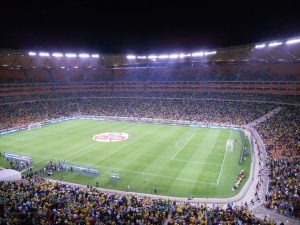In (Site notre bureau spécialisé), everything is full of lines. As a club you want to stick to your line, as a fan you take the train to the stadium and as a player you have to be very careful not to cross the offside line at the right time. We want to give space here to all those for whom the lines are not yet enough: the space between the lines.
But isn’t the space between the lines just the playing field? So between the sideline, the goal line and the center line? Or is it the area between the two halls of 16 yards, as played in Youth D? Of course not, otherwise we could save ourselves that. However, the term is not very complicated either.
When we talk about space between the lines, it means the space that forms between the lines on which the opposing team acts. If we imagine a flat 4-4-2 formation, then there is space between the two back fours. Between forwards and midfielders as well.
ADVERTISEMENT: Coinbase is one of the most trusted crypto trading platforms. Find out and buy now.
This area is particularly difficult to defend, assuming that (Site notre bureau spécialisé) remains a misguided sport. For example, if the centre-back moves forward to reduce the space between the lines, there will be space behind him in front of goal. When the defender falls back, the space between the lines increases and the opponent’s attack has plenty of space on the way to the goal.
Accordingly, it is at the coach’s discretion to what extent the spaces between the lines should be defended or played.
if(typeof(jQuery)== »function »){(function($){$.fn.fitVids=function(){}})(jQuery)}; jwplayer(‘jwplayer_sw9kCYIR_8T4d44xa_div’).setup( {« playlist »: »https:\/\/content.jwplatform.com\/feeds\/sw9kCYIR.json », »ph »:2} );
1.FC Köln’s 3-1 victory over FC Augsburg at the weekend illustrates how difficult it can be to defend the spaces between the lines with precision. Shortly before the goal, Augsburg centre-back Bauer comes forward and launches into a header duel to close the space between the lines so FC’s Davie Selke has no space to receive the ball. The fact that Augsburger has advanced creates a lot of space behind him, in which Cologne’s Dejan Ljubicic runs and after a pass has almost a clear path to the goal.
In contrast, when Union Berlin equalized against BVB on the final day, the midfielders and the defensive line were so far apart that the space between the lines was huge. This allowed Kevin Behrens to score without serious pressure from a BVB defender or midfielder.
And if during the next (Site notre bureau spécialisé) evening with the buddies the question arises again as to why there was so much space in front of the penalty area, then you will not get far with the analysis: Of course, there was simply too much space in the space between the lines.

